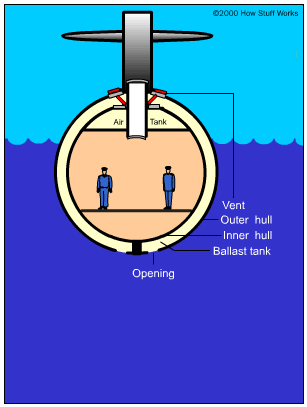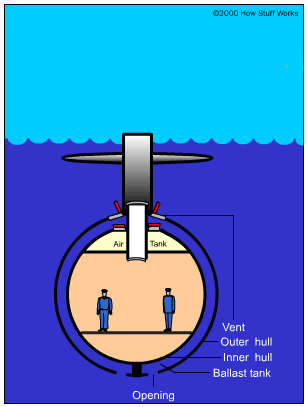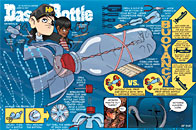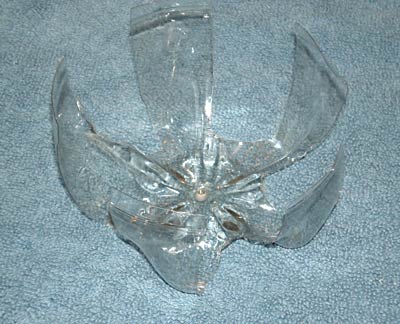Introduction
When you see a submarine underwater in a movie, it probably seems as if it's moving very slowly, but actually, submarines move very fast. The fastest submarine can travel over 40 knots, which is over 75 kilometers per hour (or 46 miles/hour)! Moving and maneuvering a large submarine underwater is a tricky task because of the forces involved: gravity, buoyancy, pressure, and friction.
First, think about the force of friction and how it is different when moving in the water. Have you ever tried running in a pool? Then you know it is much more difficult to run through water than to run through air. That is because water is more dense than air, and it is actually pushing back on you when you move. Moving though water creates a lot of friction, and submarines are designed to minimize this force by having a hydrodynamic, bullet-like shape. Submarines are also made of very strong materials, like steel, to resist the forces of high pressure the submarine encounters as it dives under the water.
Submarines are large, heavy ships that are often built with steel, so how do they float in the water? The answer is buoyancy. A submarine or a ship displaces a weight of water equal to the weight of the ship. This displacement of water creates an upward force, opposite to the pull of gravity, called the buoyant force.Submarines control their buoyancy, so that they can sink or surface, by controlling the amount of water in their ballast tanks.


Figure 1. At howstuffworks.com you can play this java tutorial showing how a submarine dives and surfaces by changing how much water it stores in the ballast tank. On the left, the ballast tank is empty, and the submarine is at the surface. On the right, the ballast tank is full, and the submarine dives underwater. (HowStuffWorks.com, 2007.)
That explains how a submarine moves up and down, but how does the submarine move forward and backward? One way for a submarine to move forward is to use a propeller, but there is a trick to this movement. When the propeller spins, it can also spin the submarine, taking away any forward movement. Without stabilizing fins, a submarine would just be a spinning tube. The stabilizing fins resist spinning by adding a force of friction, canceling out the spinning motion, which allows the propeller to push the submarine forward. The submarine can also move backward by changing the direction that the propeller spins.
In this science project, you will investigate how stabilizing fins allow forward motion of a submarine. You will build your own miniature submarine and test different types of stabilizing fins on your model. What will happen without stabilizing fins? What will happen if the fins are out of balance? Can you find the best way to use stabilizing fins to design a submarine with the most forward movement?
Terms and Concepts
To do this type of experiment you should know what the following terms mean. Have an adult help you search the Internet or take you to your local library to find out more!
- Submarine
- Friction
- Buoyant force
- Stabilizing fins
- Hydrodynamics
- Stability
Questions
- What components make a submarine work?
- How do stabilizing fins help a submarine move?
- What happens to a submarine's movement in the absence of stabilizing fins?
Bibliography
- This science project is based on the "Soda Bottle Submarine" project at howtoons.com:
Bonsen, J., Dragotta, N., and Griffith, S. (2007). Soda Bottle Submarine. Retrieved December 6, 2007 from http://www.howtoons.com/?page_id=48 - Read about how submarines dive and surface at howstuffworks.com:
Freudenrich, C. and Brain, M. (2000). How Submarines Work: Diving and Surfacing. Retrieved December 6, 2007 from http://science.howstuffworks.com/submarine1.htm - This website has a basic introduction to the physics of buoyancy:
Nave, C.R. (2005). Buoyancy. Retrieved March 28, 2008 from the Georgia State Department of Physics and Astronomy HyperPhysics website:http://hyperphysics.phy-astr.gsu.edu/Hbase/pbuoy.html - Find out how the scientific concepts of buoyancy were used to investigate "The Voyage of Doom" on NOVA:
Groleau, N. (2000). Voyage of Doom: Buoyancy Brainteasers. NOVA Online, PBS, and WGBH. Retrieved December 6, 2007 from http://www.pbs.org/wgbh/nova/lasalle/buoyancy.html
Materials and Equipment
- 2-liter soda bottle (1)
- Water bottle, standard size, approximately 500-700 mL (1)
- Razor blade or knife
- Drill with a 3/32-inch drill bit; be sure to confirm, but this size should create a hole that will fit the paper clip you'll be inserting
- Scissors
- Pen or needle
- Needle-nose pliers
- Large paper clips (2)
- Chopsticks
- Stiff ruler
- Rubber bands (3)
- Waterproof sealant (such as silicone)
- Bathtub (or pool), filled with water
- Lab notebook
Experimental Procedure
- Click on the image to view the Soda Bottle Submarine instructions found at http://www.howtoons.com/?page_id=48.

- Print out the instructions.
Making the Propeller
- To begin making the propeller, cut the bottom half off the 2-L soda bottle. Cut the bottom, as shown by the howtoons.com worksheet, to make a propeller shape that has five separate curved blades. This is difficult because the plastic is thick in certain places. Have an adult carefully use a razor blade or a knife to help you with this tricky step. See Figure 2 for a picture of the finished propeller.
 Figure 2. This is a propeller made out of a 2-L bottle, explained in the howtoons.com instructions.
Figure 2. This is a propeller made out of a 2-L bottle, explained in the howtoons.com instructions. - Have an adult drill a hole in the small water bottle cap and drill two holes in the propeller, one in the center and another just off center. Be sure to wear safety goggles when using power tools.
- Using scissors, cut a small circle of plastic out of the remains of the 2-L soda bottle. The circle should be about the same size and shape as the submarine (small water bottle's) bottle cap. This piece will go in between the bottle cap and the propeller and will serve as a washer-the propeller needs a slippery surface against which to spin. Using a pen or a needle, carefully make a hole in the middle of the washer, big enough for the tip of a paper clip to easily fit through. Use caution if you use a needle so you don't poke yourself.
- Straighten one end of one of the paper clips and feed it through the hole in the top of the bottle cap, then through the washer, and finally through the center hole of the propeller. The propeller fins should be facing down, curved away from the bottle cap.
- Bend the inside end with the needle-nose pliers, looping it through the second off-center propeller hole to secure the paper clip and two pieces together.
Making the Submarine
- To make the submarine, have an adult drill two small holes in the bottom of the water bottle, just like the holes in the propeller—one in the center and one slightly off-center.
- Straighten one end of the second paper clip and use chopsticks to insert the straight end of the paper clip through the hole of the water bottle, from the mouth of the bottle into the centered hole at the end of the water bottle. This step is tricky!
- Once you get the straight end out, use the pliers to bend the end over and hook it into the other off-center hole to secure it.
- Use the chopsticks again to hook a rubber band onto the paper clip hook inside the water bottle submarine.
- Without letting go of the rubber band, hook the other end of the rubber band loop through the paper clip hook inside the bottle cap propeller. If it is too difficult to pull the rubber band using chopsticks, use another paper clip to make a hook and use this to pull the rubber band to the hook in the bottle cap propeller. Make sure the rubber band is tight—the submarine's rubber band needs good tension or it won't be able to move. If the rubber band is too loose, try a smaller size. See Figure 3 for a picture of the connected assembly with a 2-L bottle submarine. Note: (a 2-L bottle is used in this figure because it is bigger, making the assembly easier to see—remember, you are using a smaller water bottle).
 Figure 3. This is the connected assembly. The 2-L bottle is used only as a larger visual aid—you will be using a smaller water bottle for the submarine body.
Figure 3. This is the connected assembly. The 2-L bottle is used only as a larger visual aid—you will be using a smaller water bottle for the submarine body. - Connect the ruler as a stabilizing fin, using two rubber bands. Place the ruler perpendicular and so it is just centered to the submarine. Attach it with two rubber bands that form an "X" around the bottle and the ruler.
- Using the waterproof sealant, make sure that the paper clip holes are fully sealed. Water can easily move in and out of the submarine if there are still holes, which will affect the experiment. Give the sealant enough time to dry before proceeding with the experiment—see the sealant's instructions.
Testing the Submarine's Fin
- Fill the submarine bottle about three-quarters full with water and screw on the bottle cap. The cap is not supposed to move with the propeller, so make sure it is screwed tightly.
- Using the propeller, twist the rubber band around several times to build up the potential energy. Why will this propeller work? Loot at it. What makes it force the submarine forward instead of backward? Which way should it spin? Be sure you count and record how many times you've twisted it around in your lab notebook and twist it the same number of times for every trial. Submerge the submarine in the bathtub or pool of water and let it go. Be sure to have an adult with you if you are testing this in a pool. What happens to the submarine? If your submarine:
- Sinks - let some water out.
- Floats - add more water.
- Moves forward - you are ready to start!
- Next, do a series of tests as you change the position of the stabilizing fin. Test ten different positions and observe the results each time, always recording them in your lab notebook. You will be testing the submarine without fins, and then with the fin centered, to the left, and to the right. Those three positions will each be tested at the middle, front, and back of the submarine, giving a total of nine tests, plus one for the submarine without a fin. Be sure when you shift the fins left or right that you select one increment, in inches, and use that same increment for every trial. Also, be sure that when you shift the fin forward or backward that you select a different increment, in inches, and use that same increment measured from the center of the bottle. You should record your results in a data table in your lab notebook like this one:
Direction of Movement Other Observations No Fin Middle: Fin Centered Middle: Fin to the Right Side Middle: Fin to the Left Side Front: Fin Centered Front: Fin to the Right Side Front: Fin to the Left Side Back: Fin Centered Back: Fin to the Right Side Back: Fin to the Left Side - How did the presence of the stabilizing fin affect the movement of your submarine? What was the best fin position? Why do you think stabilizing fins are important for the hydrodynamics and stability of submarines?
No comments:
Post a Comment